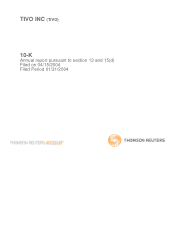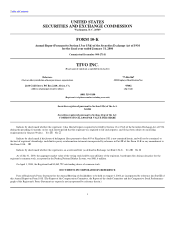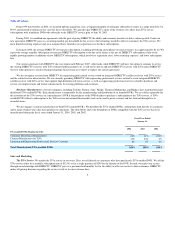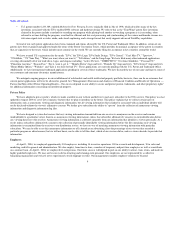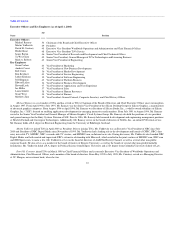TiVo 2003 Annual Report Download - page 9
Download and view the complete annual report
Please find page 9 of the 2003 TiVo annual report below. You can navigate through the pages in the report by either clicking on the pages listed below, or by using the keyword search tool below to find specific information within the annual report.
Table of Contents
Satellite and Cable DVR Competitors. The DIRECTV satellite receiver with TiVo service competes against other cable and satellite set-top boxes that
integrate basic or enhanced DVR functionality into multi-channel receivers.
• Satellite: EchoStar released the DishPVR 501 in 2001, which combined EchoStar Dish Network satellite reception with basic DVR functionality,
including repeating timer-based recordings. In July 2002, EchoStar released the DishPVR 721, which offers a limited DVR feature set. EchoStar
has also released the DishPVR 921, a system for High Definition signals. Additionally, it is possible that NDS Group PLC ("NDS") will begin
working with DIRECTV to provide additional DVR technology to DIRECTV customers.
• Cable: Scientific-Atlanta sells the Explorer 8000 integrated digital cable DVR set-top box to cable operators. This product combines digital and
analog cable reception with dual-tuner DVR functionality. Motorola has announced its own plans for integrated cable DVRs. In addition, Motorola
has announced plans to build integrated cable DVRs for cable operator Charter Communications using Moxi Media Center software from Digeo.
Other DVR technology providers targeting the integrated DVR space include set-top box manufacturers Pioneer and Pace, and software providers
NDS and Canal+ Technologies.
• Video on Demand: U.S. cable operators are currently deploying server-based Video on Demand (VOD) technology from SeaChange, Concurrent,
nCube, and others, which could potentially evolve into competition. Server-based VOD relies on content servers located within the cable operator's
central head-end that stream video across the network to a digital cable set-top box within the consumer's home. Cable operators can use VOD to
deliver movies, television shows, and other content to consumers. Consumers can watch this programming on demand, with VCR-like pausing and
rewinding capabilities. Operators can charge consumers for access to VOD content on a per-transaction or monthly subscription basis, or can offer
content without charge. To the extent that cable operators begin to offer regular television programming as part of their VOD offerings, consumers
will have an alternate means of watching time-shifted shows other than using DVRs.
Licensing Fees. Our licensing revenues depend both upon our ability to successfully negotiate licensing agreements with our consumer electronics and
service provider customers and, in turn, upon our customers' successful commercialization of their underlying products. In addition, we face competition from
companies such as Microsoft, OpenTV, NDS, D&M Holdings, Digeo, Ucentric, and Gotuit who have created competing digital video recording technologies.
Such companies may offer more economically attractive licensing agreements to service providers and manufacturers of DVRs. Going forward, in our
relationships with manufacturers and distributors, we are shifting focus from upfront license and engineering professional services payments to recurring
royalty and service payments. We expect future technology revenues to decline from the fiscal years 2004 and 2003 levels as we complete existing contracts.
Established competition for advertising budgets. Digital video recorder services, in general, and TiVo, specifically, also compete with traditional
advertising media such as print, radio, and television for a share of advertisers' total advertising budgets. If advertisers do not perceive digital video recording
services, in general, and TiVo specifically, as an effective advertising medium, they may be reluctant to devote a significant portion of their advertising
budget to promotions on the TiVo service. In addition, advertisers may not support or embrace the TiVo technology due to a belief that our technology's
ability to fast-forward through commercials will reduce the effectiveness of general television advertising.
Patents and Intellectual Property
We have filed patent applications covering many critical aspects of the design, functionality, and operation of a TiVo digital video recorder. We have
been awarded 61 foreign and domestic patents, have 60 foreign and domestic patent applications pending, and have one provisional patent application
pending. We have also filed patent applications that cover technology we intend to incorporate in future versions of the TiVo service and hardware. Patents
we hold the rights to include:
• U.S. patent number 6,327,418, entitled Method and Apparatus Implementing Random Access and Time-Based Functions on a Continuous Stream
of Formatted Digital Data, originally filed in April of 1998, which describes a method of controlling streaming media in a digital device. We refer
to this as the "TrickPlay" patent. The TrickPlay patent covers the functions of the TiVo-enabled DVR that enable viewers to pause live TV as well
as rewind, fast-forward, play, play faster, play slower, and play in reverse television signals cached by the DVR. The patent also claims methods
for storing, editing, and manipulating video.
8

